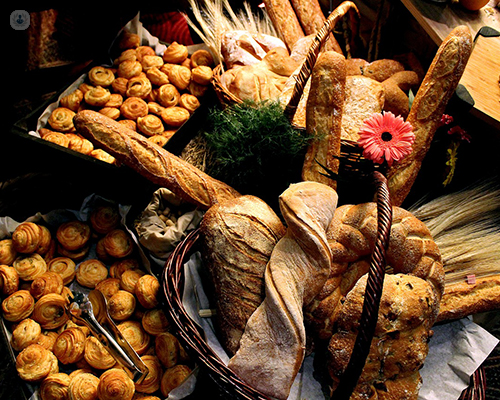An expert's guide to ultra-processed foods and gut health
Escrito por:The saying ‘you are what you eat’ is a contemporary adage first coined in 1825 by a Parisian gentleman called Jean Anthelme Brillat-Savarin. As our knowledge of the link between food and our gut microbiota grows rapidly, this aphorism seems more and more poignant. Over the past 30 years, we have undergone significant lifestyle and dietary changes. There have been concerns raised about how the increase in processed foods in our diet, which is often a result of urbanisation and westernisation, may affect our gut health. In his latest online article, leading consultant gastroenterologist Dr Ravi Misra explains the different food groups and their impact on our gut health.

What are processed foods?
"Food processing" refers to the procedures and processes used to transform fresh foods into finished products. Washing, cutting, heating, freezing, packaging, and the addition of chemicals are just a few of the processes that can alter a food's properties, including its nutritional makeup. This involves dietary augmentation.
While it may not always hold true, there is a narrative that classifies all types of processing, particularly considerable amounts of processing, as less healthy or desirable. Processed foods are categorized by the British Dietetic Association into 4 groups.
Group 1:
Unprocessed or minimally processed foods are edible parts of plants (seeds, fruits, leaves, stems, roots) of animals (muscle, offal, eggs, milk), or fungi and algae. Natural foods that have undergone minimal processing include those that have had undesirable or inedible components removed, as well as those that have undergone roasting, boiling, non-alcoholic fermentation, pasteurization, refrigeration, chilling, freezing, containerization, and vacuum packaging.

These procedures aim to preserve natural foods, make them fit for storage, or improve their safety, palatability, or overall enjoyment.
Group 2:
Processed culinary ingredients, such as oils, butter, sugar and salt, are substances derived from either Group 1 foods or nature, by processes that include pressing, refining, grinding, milling and drying.
These procedures are done to create long-lasting goods that can be used in both home and commercial kitchens to prepare, season, and cook Group 1 foods as well as to create a variety of dishes and meals, including stews, soups and broths, salads, breads, preserves, drinks, and desserts. They are typically combined with Group 1 foods to create freshly prepared drinks, dishes, and dinners; they are not meant to be consumed on their own.
Group 3:
Processed foods, such as cheeses, fresh breads, canned fish, fruits in syrup, and canned vegetables, are essentially manufactured by adding salt, oil, sugar, or other ingredients from Group 2 foods to Group 1 foods.

Various preservation or cooking techniques, as well as non-alcoholic fermentation in the case of breads and cheese, are all examples of processes. Most processed foods are recognized as modified versions of Group 1 foods because they often only contain two or three ingredients. They can be consumed alone or, more frequently, in combination with other foods. Here, processing is done to make Group 1 meals more enduring or to change or improve their sensory characteristics.
Group 4:
Soft drinks, sweet or savoury packaged snacks, reconstituted meat products, and pre-made frozen meals are examples of ultra-processed foods. These foods are not modified foods; rather, they are formulations built primarily or totally from ingredients taken from foods and additives, with little to no intact Group 1 food. These formulas typically contain ingredients that are also found in processed foods, such as salt, sugar, oils, and fats.
However, ultra-processed foods also contain additional energy and nutrient sources that aren't often present in food preparations. Some of them, such as casein, lactose, whey, and gluten, are taken straight from food.
Are all processed foods bad?
The answer to that is no. But the devil is in the detail. If products in group 2 have been altered in order to keep them edible to get your dining table they can serve as an important vehicle to enable access to a varied diet. However, processed foods with high levels of sugar and salt can affect glucose control and blood pressure.

Some additives used in processed meals, such as preservatives, antioxidants, and stabilizers, are also present in ultra-processed foods. Certain types of additives used to mimic or improve the sensory attributes of foods or cover up unappealing elements of the finished product are only found in ultra-processed items.
These additives include dyes and other colours, colour stabilisers; flavours, flavour enhancers, non-sugar sweeteners; and processing aids such as carbonating, firming, bulking and anti-bulking, de-foaming, anti-caking and glazing agents, emulsifiers, sequestrants and humectants.
To combine the numerous ingredients and produce the finished product (thus the term "ultra-processed"), numerous sequences of operations are utilized. Several of the procedures, such as hydrogenation and hydrolysation, extrusion and moulding, and pre-processing for frying, don't have domestic analogues.
How does ultra-processed food affect the gut?
Chronic inflammatory diseases are associated with alterations in the species and composition of the intestinal microbiota. The majority of studies assessing the impact of chemicals used in food processing in the gut have been performed in mice. Therefore, the demonstrated changes may not necessarily translate to humans.

One study examined the impact of two emulsifiers polysorbate 80 (P80) and carboxymethylcellulose (CMC) on the microbiota using a mucosal simulator of the human intestinal microbial ecosystem. This approach revealed both products acted directly upon the human microbiota to increase its proinflammatory potential. Non-caloric artificial sweeteners are among the most widely used food additives worldwide, regularly consumed by lean and obese individuals alike.
Another landmark study examined the impact of three commercial formulations of saccharin, sucralose and aspartame in mice and humans in a series of experiments. It was demonstrated that consumption in both mice and humans enhances the risk of glucose intolerance and that these adverse metabolic effects are mediated by modulation of the composition and function of the microbiota. Notably, several of the bacterial taxa that changed following artificial sweetener consumption were previously associated with type 2 diabetes in humans.
Silver is a grey colour natural metal obtained from the silver gem. It is used as a colourant in candy and chocolate surface coating. Studies have examined the impact of 28 days of exposure to dietary silver in a mouse model. They demonstrated the persistence of silver in the digestive tract of mice followed by a reduction in bacterial diversity.
What should we eat?
I think a basic premise is to try and stick to foods in Groups 1 and 2 and avoid Group 4 products. Aim to reduce the amount of food you eat from packets and eat more foods that don’t have a label. The vegetable aisle of a supermarket doesn’t have any packaged products! Following these simple tips will lead to increased gut microbial diversity and reduced pro-inflammatory potential and potentially an overall improvement in gut health.
Dr Ravi Misra is a renowned consultant gastroenterologist based in London, with over 15 years of experience. If you would like to book a consultation with Dr Misra, you can do so today via his Top Doctors profile.


